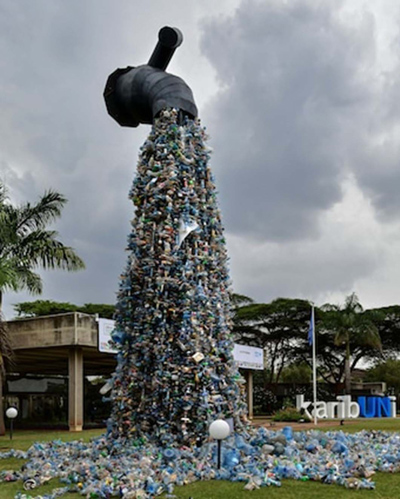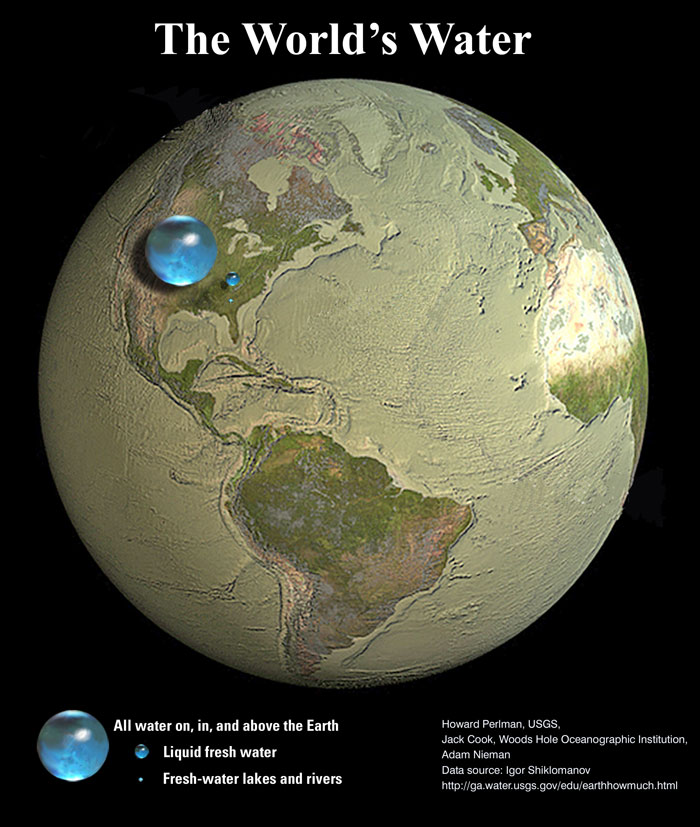Environment
Water: The Essential Ingredient

By David Mark Greaves
Water is a finite resource, the basis of all life as we know it. Yet, it is so readily available for us here at the foot of New York’s glorious watershed that we sometimes forget how uneven that availability is, how much it is being polluted, and how truly little of it there is.
The blue globe on the opposite page represents all the water in the world, not just the tiny portion we can use. That’s represented by the smallest of the three globes.
National Geographic says that humanity inserts into the ocean portion “about 8 million tons of plastic waste… …That’s the equivalent of setting five garbage bags full of trash on every foot of coastline around the world.”
In this plastic deluge into the seas, The Ocean Cleanup, a not-for-profit dedicated to doing just that, points out what happens to the plastic chunks. “Degradation is slow but constant, so the larger objects are a ticking time bomb, breaking down over time and raising levels of microplastics exponentially.”
These smallest pieces are mistaken for food and eaten by the smallest sea creatures, and as bigger fish eat the little fish, the toxins in the plastics work their way up the food chain to our kitchen table.
More plastic than fish
The Plastic Soup Foundation is a not-for-profit whose mission is to inform the public of the danger at hand. They say, “Plastic production will increase by 40% in the next ten years. If we don’t do anything about the plastic soup, oceans will carry more plastic than fish (by weight) by 2050. The United Nations warns that marine life will be irreparably destroyed. Coral reefs appear to be particularly vulnerable to plastic pollution. The plastic soup will endanger the food supply of millions of people.”
2050 is only 27 years away.
Apart from the oceans, only potable after desalination, the only freshwater available is represented not by the second orb, where “99 percent is groundwater, much of which is not accessible to humans,” but by the smallest blue orb, some 34.9 miles across.
Into this tiniest of portions is injected “forever chemicals,” being washed down sewers in the street and drains in the home.
Studies show nearly all Americans have some level of PFOA, PFOS, and similar chemicals, scientifically known as per- and polyfluoroalkyl substances (PFAS), circulating in their bodies. Additional analyses calculate that hundreds of millions of Americans are probably exposed through drinking water contamination. The Guardian
The Minnesota Department of Health, studying the potential health effects of these chemicals found that in some studies, higher levels of PFOA in a person’s body were associated with higher cholesterol, changes to liver function, reduced immune response, thyroid disease, and increased kidney and testicular cancer.
Milwaukee Journal Sentinel reported that “The levels of ‘forever chemicals’ found in fish harvested from the Great Lakes are much higher than in commercially raised fish, according to a new study.
“One serving of locally caught freshwater fish could be equivalent to drinking water with PFOS at 48 parts per trillion for a month, researchers said. Last summer, the Environmental Protection Agency released guidance that humans shouldn’t consume more than 0.02 parts per trillion of the compounds.
(This is personally meaningful for me as my fishing trips to Lake St. Claire will now be catch and release as the recommendation is to only have one serving of catfish a year from those waters.)
It isn’t just the endangered surface water; the overuse of the nation’s and the world’s available groundwater supply is also of growing concern.
“Groundwater is the largest source of usable, fresh water in the world,” notes the Groundwater Foundation, “In many parts of the world, especially where surface water supplies are not available, domestic, agricultural, and industrial water needs can only be met by using the water beneath the ground.”
In the Aug. 29, 2023 issue of The New York Times, they report, “A New York Times investigation has found that America is depleting its invaluable reserves of groundwater at a dangerous rate.
“The declines threaten the long-term survival of communities that depend on groundwater and lack alternatives.
“The change is already happening in parts of Kansas, where 2.6 million acres of land no longer have enough groundwater to support large-scale agriculture.
“Charles County, which includes fast-growing suburbs of Washington, relies on groundwater, but within a decade, that groundwater will no longer meet its needs.”
It is no wonder that the youth are marching and demanding action on climate change and pollution. They see an older generation that is leaving behind an overheated and polluted world and who won’t take the steps to fix it.
Human nature is sympathetic to the situation, but policy works better. New York Attorney General Letitia James’ suit against PepsiCo over their plastic products polluting the Buffalo River is an example of the beginning steps needed to fix the problem at the source.

The largest sphere represents all of Earth’s water. Its diameter is about 860 miles (the distance from Salt Lake City, Utah to Topeka, Kansas) and has a volume of about 332,500,000 cubic miles (mi3) (1,386,000,000 cubic kilometers (km3)). This sphere includes all of the water in the oceans, ice caps, lakes, rivers, groundwater, atmospheric water and even the water in you, your dog and your tomato plant.
Liquid freshwater
How much of the total water is freshwater, which people and many other life forms need to survive? The blue sphere over Kentucky represents the world’s liquid freshwater (groundwater, lakes, swamp water and rivers). The volume comes to about 2,551,100 mi3 (10,633,450 km3), of which 99 percent is groundwater, much of which is not accessible to humans. The diameter of this sphere is about 169.5 miles (272.8 kilometers).
Water in lakes and rivers
Do you notice the “tiny” bubble over Atlanta, Georgia? That one represents freshwater in all the lakes and rivers on the planet. Most of the water people and life on earth needs every day comes from these surface-water sources. The volume of this sphere is about 22,339 mi3 (93,113 km3). The diameter of this sphere is about 34.9 miles (56.2 kilometers). Yes, Lake Michigan looks way bigger than this sphere, but you have to try to imagine a bubble almost 35 miles high—whereas the average depth of Lake Michigan is less than 300 feet (91 meters).
The data used on this page comes from Igor Shiklomanov’s estimate of global water distribution shown in a table below.
Credit: Howard Perlman, USGS; globe illustration by Jack Cook, Woods Hole Oceanographic Institution (©); Adam Nieman.
Data source: Igor Shiklomanov’s chapter “World freshwater resources” in Peter H. Gleick (editor), 1993, Water in Crisis: A Guide to the World’s Freshwater Resources (Oxford University Press, New York).








